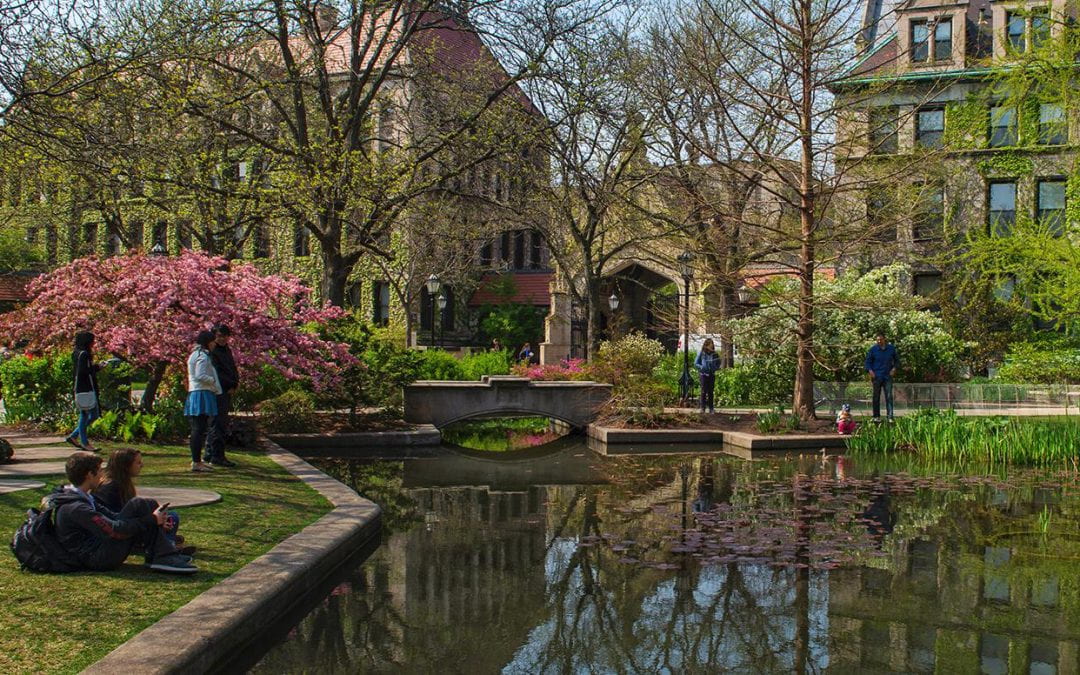by Elise Wachspress
Among the most beloved spaces on the UChicago campus is Botany Pond, created by the first chairman of the University’s Botany Department. Tucked between the University’s iconic Reynolds Club, where everyone meets for food and performances, and the Anatomy Building, Botany Pond provides both a natural respite and a physical reminder of Chicago’s storied—and ongoing—research in ecology and evolution. This pocket woodland enclave, so popular it has its own live YouTube channel, provides a home for a surprisingly wide assortment of life, with trees, plants, fish, turtles, ducks, birds, and insects, right in the middle of a busy urban environment.
UChicago scholars have studied Botany Pond—and many other environmental niches around the world—for over a century, but the field of ecology really came into broad public consciousness with the work of Rachel Carson, a marine biologist for the US government. Her passionate, graceful writing, first in The Atlantic and later in popular books that culminated in the blockbuster Silent Spring, popularized understanding of how ecosystems work and how changing single factors in an ecosystem could resonate in unexpected and dramatic ways.
Sam Light, PhD, is himself an ecosystem explorer, though his targets present some very particular challenges. Light studies the relationships among members of the ecosystems inside our bodies. Understanding the inter-relationships among these organisms, so tiny, transient, and specialized to their micro-environments, depends on developing strategies and tactics even more inventive and dogged than Carson’s.
These internal micro-environments are as many and diverse as any woodland. There are high-acid niches (like in our stomachs) and others with no oxygen (as in most of our gut). Microbes inhabit the sticky mucosal surfaces of our intestines, ride through the alimentary canal with dietary fiber, or glom onto particles of fat. But what is hard to fathom is just how many gradient niches there are between these and many other micro-environments, each with very specific local conditions that provide discrete sweet spots for various types of bacteria to thrive.
For context: imagine a wildflower seed blown into a woodland environment. If the ground is fertile enough, the moisture right, and the seed’s not eaten by a bird or trampled by a raccoon, it may sprout. To capture the energy it needs to grow, the seedling can “lean” into the dappled sunlight and send its roots toward the moistest sections of the soil, using all the talents accumulated over its evolutionary history to do what all living things “want” to do: live.
Now imagine if this little plant could actually pick itself up and move to a sunnier, more amenable location. Or if it could reproduce every hour and scoot its “babies” off to a slightly more felicitous nook. What if successive generations could gravitate to the ever-so-slightly cooler air fostered by the moss a few centimeters away? Or benefit from the negligibly increased acidity provided by a nearby decaying leaf? Or inch toward the animal scat that could provide better nutrients?
You get the idea. Our inner bacteria can do just this sort of thing, optimizing their environmental position more fluidly and quickly than any wildflower seed. And unlike wildflowers, many are also adept at sharing genes—what is known as horizontal gene transfer—adapting to their environment by borrowing pieces of genetic code from their next-door neighbors. All these abilities make for a remarkably dynamic and complex ecosystem.
And just as in macroscopic ecosystems, there are food chains. One microbe digests a certain kind of carbohydrate (corn sugar from your taco?) and then excretes a fermented version, which turns out to be the perfect energy source for a neighboring bacterium. And of course when that second microbe metabolizes the fermented sugar, it puts out its own waste products, which are just the sort of nutrients that yet another member of the microbial community loves to consume. The more symbiotically the microbes can arrange themselves in each specialized niche, the better and more efficiently the entire gut community works.
The end products of this microbial food web eventually make it into our blood stream. These digested molecules provide our cells energy and vitamins, act as links in our cellular communications, help control our neurological responses and appetites, activate or tamp down our immune responses, prompt our system to release hormones, even break down drugs into the molecules that intervene in disease processes. So the more diverse our microbial communities, the healthier we tend to be.
Light wants to figure out the details of the connections between these microbial metabolisms, how they structure beneficial communities, and the how their end products affect our health. One type of bacterium Light has been studying recently is Listeria, known for causing a food-borne infection that can be fatal.
Light’s work has demonstrated that Listeria’s peculiar metabolism can end by directly ejecting electrons out of the cell. In the absence of oxygen, this property allows Listeria to respire an unusual set of chemicals that includes mineral iron. In the lab, these electrons can be captured with an electrode and used to convert microbial metabolism into electricity.
In the oxygen-free gut, Light has found that electron-ejecting properties give Listeria an advantage over others in the intestinal community—problematic in the case of this bad citizen. Light is hoping to understand the effects of this electron-ejecting property and determine how to tilt the ecological balance in favor of other, friendlier bacteria.
Learning how to effectively manage our internal ecosystems—a goal of the Duchossois Family Institute—may be just as important as optimizing those larger ones we inhabit.
Elise Wachspress is a senior communications strategist for the University of Chicago Medicine & Biological Sciences Development office




